One of the most important decisions a patient needs to make is which type of hair transplant procedure to have: FUT/Strip or FUE. In Follicular Unit Transplantation (FUT/Strip), a long, thin sliver of tissue removed from the donor area in the back and sides of the scalp and the individual follicular units are removed from that strip via stereo-microscopic dissection. The wound edges are then closed leaving a single, generally fine scar. In Follicular Unit Extraction (FUE) hair is harvested through small circular incisions over a considerably larger area of the donor zone leaving tiny, round, white scars.
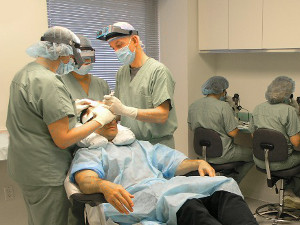 Dr. Bernstein performing FUT hair transplant
Dr. Bernstein performing FUT hair transplantFUE procedures have grown increasingly popular with the development of new handheld devices and especially since the introduction of the ARTAS Robotic Hair Transplant System, but FUT or “Strip” procedures still provide excellent results and are considered the “gold standard” by many doctors. On this page, we will explore the pros and cons of FUT/Strip vs FUE in detail. We will use the terms FUT/Strip and FUT interchangeably.
For a detailed summary of the advantages and disadvantages of Follicular Unit Extraction (FUE) compared to Follicular Unit Transplant (FUT/Strip) see: FUE vs. FUT – A Detailed Summary
Main Advantages
The main advantage of Follicular Unit Transplantation (FUT/Strip) is that it typically (but not always) gives the highest yield of hair. When a patient’s primary goal is to achieve maximum fullness from the hair restoration, FUT should be considered. There are many reasons for this, including the precision of stereo-microscopic dissection and the ability to efficiently harvest from a more select area of the donor zone.
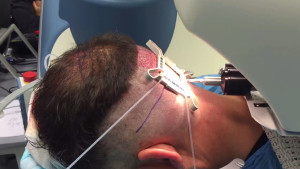 FUE Hair Transplant with the ARTAS Robot
FUE Hair Transplant with the ARTAS RobotThe main advantages of Follicular Unit Extraction (FUE) are not leaving a linear donor scar and having a faster healing time. When the patient’s primary goal is to be able to wear their hair very short or return quickly to strenuous activity, FUE is ideal. FUE is also indicated when there is an increased risk of a widened scar or when scalp laxity (looseness) does not permit a strip excision. The patient may sometimes choose FUE simply to avoid the stigma of a linear donor scar even though it would be easily covered by their hair.
Can the Same Person Have Both FUT and FUE?
Yes. FUT may be used first to maximize the yield of the initial procedure(s), but then in subsequent sessions, the scalp may become too tight to perform further FUT/strip procedures or the donor scar may become wider than anticipated. In the former case, the physician can switch to FUE for subsequent sessions. In the latter, the surgeon may use FUE to harvest follicular units and then implant them into the widened scar, camouflaging it.
If FUE is performed first and the yield is lower than what the doctor deems acceptable, the patient may consider switching to FUT either for the remainder of that procedure or in subsequent surgeries.
Should I See FUT or an FUE Specialist?
Both FUT and FUE are excellent techniques, but they have different clinical indications. To deliver the best care for patients, hair restoration physicians should have expertise in both procedures, and they should offer both in their practices. For a detailed explanation, see Why Visit a Practice That Specializes in Both FUT and FUE?
[cta]
Graft Quality: FUT vs. FUE
In both procedures, it is important to transplant high-quality follicular unit grafts to achieve the maximum cosmetic benefit from the hair restoration. High-quality grafts are ones that are obtained from the most permanent part of the donor area, are undamaged and contain a protective layer of tissue around the follicles. The protective dermis reduces mechanical injury during insertion and from drying when the grafts are outside the body.
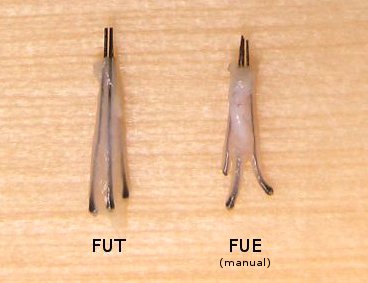 LEFT: A 3-hair follicular unit obtained via FUT and stereo-microscopic dissection. Note that the follicles and protective connective tissue are intact. RIGHT: A 3-hair follicular unit obtained through manual FUE. Note the transected follicle and bulbs devoid of protective connective tissue
LEFT: A 3-hair follicular unit obtained via FUT and stereo-microscopic dissection. Note that the follicles and protective connective tissue are intact. RIGHT: A 3-hair follicular unit obtained through manual FUE. Note the transected follicle and bulbs devoid of protective connective tissueIn FUT, the donor strip is first removed from the scalp and then, with the aid of dissecting stereo-microscopes, the follicular units are carefully isolated with their protective tissue intact. This process typically yields high-quality grafts, especially when clinical assistants are extensively trained in stereo-microscopic dissection.
In FUE, the surgeon extracts follicular units from the donor area one at a time. There is some risk of transecting (cutting) the follicular units during the harvesting because only the upper part of the follicle can be directly visualized. The direction of the hair follicles below the surface of the skin can only be estimated. As a result, follicular units are more likely to be damaged or stripped of their protective layer during FUE than with FUT. For a more detailed discussion of this issue, see Graft Quality: A Challenge of FUE.
If the surgeon does not cut deeply enough into the skin, the follicular unit may be extracted without the important lower portion of the follicle and it may not survive the transplant. These factors can result in lower quality or damaged grafts, making them more fragile and subject to poor growth.
With Robotic FUE hair transplant technology, the quality of grafts in FUE is better and more consistent compared to manual FUE techniques and so this important difference between FUT and FUE procedures is reduced.
Utilizing Donor Hair: FUT vs. FUE
Another difference between FUT and FUE is the proportion of follicular units that are harvested from the mid-portion of the donor zone. Follicular units at the outer edges of the donor area are more likely to be lost over time due to the progression of the balding process, but those from the mid-portion of the donor area tend to be more resistant to balding.
In FUT, the donor strip is removed from the mid-portion of the permanent zone, whereas in FUE, follicular units are harvested from a much broader region to obtain a sufficient number of grafts. This makes it more likely that, in FUE, some of the follicular units may actually be lost to the balding process over time.
In FUE, the surgeon is only able to harvest about one out of every five follicles in a given area or 20% (this compares with 100% using FUT/Strip). Because of this, the surgeon may be tempted to harvest hair from the upper and lower margins of the donor area to have sufficient hair for the transplant. In doing so, they risk the hair being of poor quality or non-permanent. If too much hair is removed from the mid-portion of the permanent zone, a visibly thinned donor area may result.
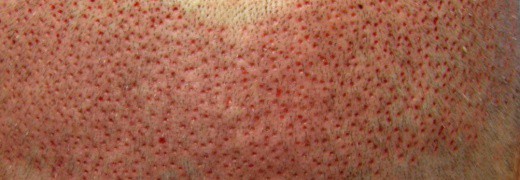 Donor Sites in FUE
Donor Sites in FUEIn Follicular Unit Extraction the wounds, although small, are left open to heal, leaving hundreds to thousands of tiny scars. Although not readily apparent, this scarring distorts adjacent follicular units and makes subsequent sessions more difficult. This is an additional factor that limits the total available donor supply in FUE. In FUT, the scarring is consolidated into one single line – even after multiple procedures.
Although new techniques and instrumentation significantly decrease the amount of transection and damage during the extraction process, the inability to fully access the mid-portion of the permanent zone in a hair transplant procedure still limits the total amount of hair available with FUE. This represents a significant disadvantage of FUE since a limited donor supply is the main factor that prevents a complete hair restoration in many patients, particularly those with moderate to advanced balding.
Donor Scarring
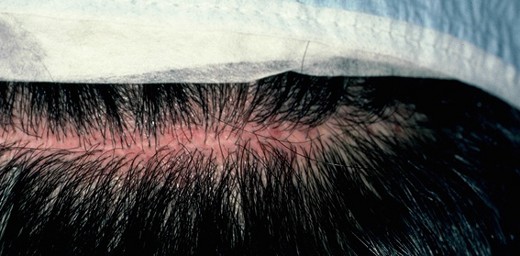 Linear Scar in FUT Hair Transplant
Linear Scar in FUT Hair TransplantThere are several important differences when it comes to the scarring left after FUT and FUE procedures in the donor area.
In FUT, the strip is taken from the mid-portion of the donor area and the wound edges are then sewn or stapled closed leaving a single, generally fine scar. While this can become visible if someone wears their hair very short, it is usually covered by hair and hidden from sight. If someone who had a prior FUT hair transplant has another strip procedure, the initial scar is removed when the subsequent donor strip is excised. As a result, the patient will only be left with one linear scar regardless of how many FUT procedures they have.
In FUE, the tiny, white dot scars that remain after the procedure can be difficult to see even with short hair. This makes FUE popular with people who crop their hair or have a very short hairstyle. If, however, the patient seeks a second or third FUE procedure, the dot scars from subsequent procedures are added to those from the initial procedure. This scarring can distort adjacent follicular units and make subsequent sessions more difficult. This is an additional factor that limits the total available donor supply in FUE.




